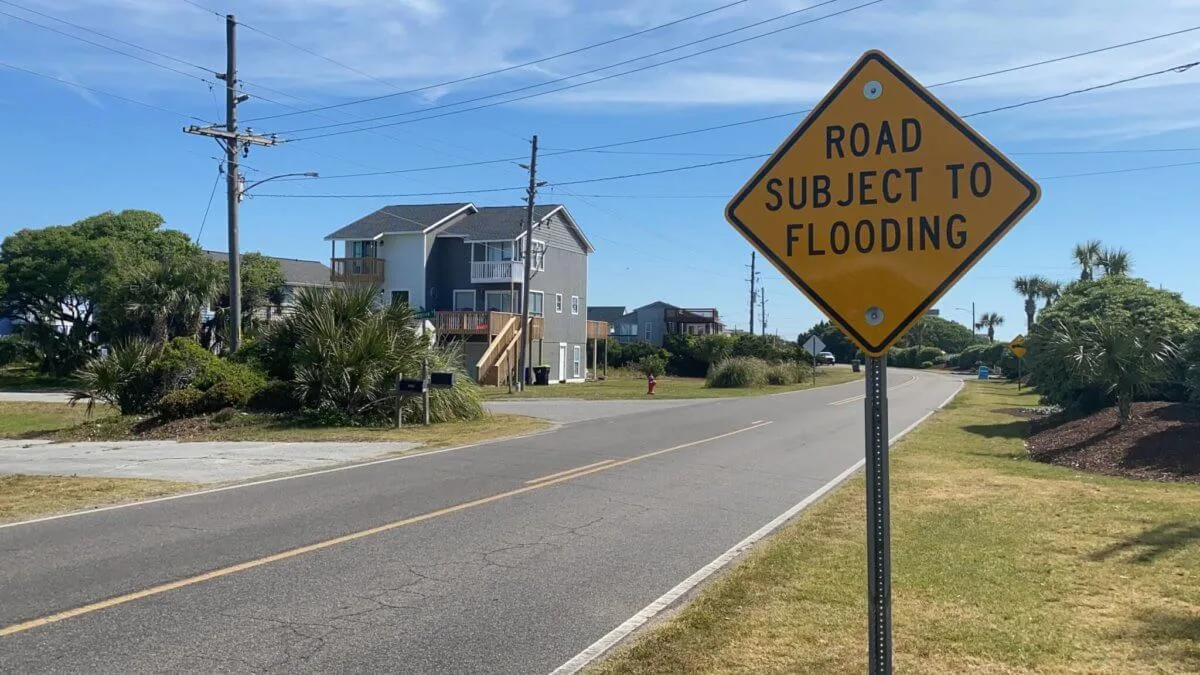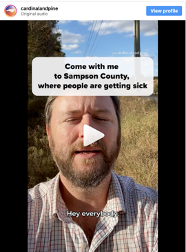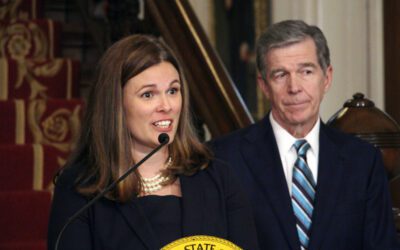
A sign warns motorists and others of flooding on New River Inlet Road in North Topsail Beach. A 2019 study by the Center for Climate Integrity, estimates that it will cost $724 million to adequately provide short term protection against flooding in N. Topsail. (Photo by Michael McElroy)
Joe Biden has made responding to climate change a priority of his presidency. Here’s what that means for North Carolina.
North Carolina’s beaches, which bring billions in tourism dollars each year, are in danger of disappearing under rising seas.
The state’s $93 billion agriculture industry could wilt from record-breaking heat that’s now the norm.
Raleigh and Charlotte could see a huge influx of climate refugees from Miami and other other coastal cities over the next 20 years, further straining resources in the state.
Climate change is a direct threat to North Carolina. And it’s happening now.
But, President Joe Biden, who marked his 100th day in office Friday, has rolled out proposals that climate scientists say are necessary to avoid the worst-case effects of climate change.
Here is a look at the moves the Biden administration has taken and what it could mean for our state.
North Carolina’s Threatened Environment
First, let’s talk about North Carolina, a state with a diverse environment that stretches from the tourism-dependent coasts that see rising sea levels, across vulnerable farmlands, and up into the mountains where drought, extreme heat, and wildfires are likely to become more common.
A warmer planet means rising sea levels, stronger and more frequent storms, increased drought, increased food and water shortages, the emergence of novel diseases, and lots more horrible things that could ruin local economies and devastate quality of life for most of the planet.
But you don’t have to be a climate scientist to know that climate in NC is not what it used to be, Dr. Kathie Dello, the director of the NC Climate Office, says.
“People are really observant and smart and they can see that things are changing,” Dello told Cardinal & Pine. “They don’t need the state climatologist to point to a flooded road and say ‘That road is flooded.’”
She added, “Climate change is here and now. It’s not a future thing.”
According to a report Dello co-wrote with the NC Institute for Climate Sciences, the rise in temperature in the state has accelerated over the last few decades, with the hottest years on record all coming in the last ten years.

Rising temperatures means a warmer ocean, which means rising seas and stronger and more frequent hurricanes that slam the fragile beaches of the Outer Banks, Topsail Beach and other popular coastal areas.
The biggest driver of this rise in temperature and rising seas, both in NC and globally, is the increase of heat-trapping gasses like carbon dioxide and methane that result from the burning of fossil fuels.
Under Biden’s direction, the Federal Emergency Management Agency (FEMA) is looking at expanding current disaster response funding to include prevention efforts. The money, currently earmarked only for disasters that are underway or just happened, could be broadened to help local communities fund beach nourishment projects, sea walls, or other mitigation efforts that could prevent coastal erosion, flooding and the loss of homes, businesses and lives. The change, which is still being reviewed, would mean more grants to places like the Outer Banks, Topsail and other major parts of NC’s tourism industries.
The Biden Administration’s climate efforts so far have taken direct aim at reducing these emissions, making the fight against climate change a national priority and at restoring the US as a leader in the global fight.
Below are four ways the Biden administration is addressing climate change.
1. Rejoining the Paris Climate Accord
The US signed the Paris Agreement under the Obama administration in 2015, joining 195 other countries in pledging to reduce carbon emissions.
But Donald Trump withdrew the US from the Paris Agreement, leaving much of the world skeptical about the US’s commitment to addressing climate change, even under the Biden administration.
Biden signed an executive order on Day One, bringing the US back into the agreement.
By rejoining the Paris Agreement, it puts the US back on track for an emission goal scientists say is urgently needed, starts to repair the country’s reputation and could convince other countries to improve their efforts knowing that the US is doing so as well.
2. Hosting the World Climate Summit
One of Biden’s first climate-related promises on the campaign trail was to convene a world summit within the first 100 days to discuss the threat of climate change and highlight the renewed global commitment to do something about it. Biden hosted the virtual summit last week.
“I think holding this summit so soon after Biden started was a good thing and signaled that America is serious about this,” Dello said.
Fighting these things will take a global effort, scientists and world leaders agree, and the key to that global effort is American leadership. The US is the second largest emitter of carbon dioxide in the world behind China, but China has already made significant pledges. So leadership from the US president is vital both to persuading Congress to act and to convincing the world that the US is serious. The US cannot solve the crisis on its own, but the world needs the US to do so.
There is no separating the global from the local on climate change.
“If North Carolina alone were to say ‘we’re going to tackle this problem just by ourselves,’ we’re not going to change much of our trajectory,” Dello said. “It will take a global effort.”
As important as it was to keep the promise to hold the summit, it was the pledge that Biden made at the meeting that is the big deal.
3. Pledge to Reduce Emissions by 50%
Biden said at the summit that the United Staes would reduce its greenhouse gas emissions by at least 50% from 2005 levels, a significant undertaking that will require a complete overhaul of the US energy sector (which is currently dependent on the burning of fossil fuels).
Such a move would require lots of political and individual will, but it would also make a huge difference.
First, let’s look at how this all works. We burn coal and other fossil fuels to convert them into the energy that powers are homes, fuels our cars and engines, and drives our livelihoods. But when coal is burned it releases vast amounts of carbon dioxide which then gets stuck in our atmosphere and takes at least a hundred years to break down. While it’s trapped, carbon dioxide does some trapping of its own, capturing heat from the sun as it bounces off of the Earth’s surface and preventing it from escaping into space. That heat radiates back toward Earth, and there you go.
A similar process follows the methane emitted during oil and gas production and lots of other industry-tied greenhouse gases.
So to reduce the amount of greenhouse emissions is to lower the rate at which our planet heats up. And a significant reduction is not some metric of the ideal, it is necessary to avoid the worst of the worst-case scenarios. If we don’t hit that mark, the consequences are inevitable.
A warmer planet means a more volatile atmosphere with a capacity to to both bring record levels of rain and widespread drought. It’s how emissions in India have a direct effect on the climate in NC.
“I don’t know where we will be able to run to to escape climate change,” Dello said
But the emissions pledge is a great start, she said.
“What was pledged last week was really encouraging and ambitious and necessary.”
She added: “It’s part of our morality to decrease our emissions.”
4. Proposals in the American Jobs Plan
Wait, there’s more. The infrastructure proposal put forth by the Biden administration casts the fight against climate change as a key part of our daily lives, devoting vast resources and funds to reshaping the energy sector, bolstering crumbling roads, bridges, pipes and roadways, and protecting what has already been built from catastrophic loss in property and lives.
The plan would help address the 1,460 bridges and more than 3,116 miles of highway in NC that are deemed in poor condition, according to a fact sheet released by the White House. In the Outer Banks and Topsail, for instance, there are few roads leading to the mainland. Poor roads and old bridges can be deadly in a flood and cut off an entire community for days. And extreme weather events cost NC some $50 billion in damages over the last decade, the White House says.
“A good infrastructure plan is climate resilience,” Dello said. “We’re unprepared across the entire country for the climate we have now, let alone the climate 50 years from now. So shoring up our bridges and roads and beaches and homes – this whole government approach to climate action is a good one.”
The plan will do so many things both nationally and in NC that we need a long list: It will expand mass transportation options and commuter rail; fund climate-resilient affordable housing in at risk areas; help renew the electric grid; improve energy efficiency in homes and businesses; help reduce pollution in underserved areas, many of which are rural and communities of color; and help pay for beach nourishment and agricultural resource management in of the state that could see the most dire effects of climate change and economic catastrophe.
The list goes on.
Hard Decisions Coming
These proposals and actions, however, will require far more than 100 days of commitment. The plan must be passed by Congress and there is huge resistance among Republicans to even small versions of these plans, and individuals are going to have to make some hard decisions about what is important to them, rethinking how they commute, heat their homes, keep the lights on, etc.
And the financial cost of the plan is huge. Many Republicans point to the nearly $3 trillion dollar price tag as reason to cast aside the American Jobs Act and its goals.
But to focus on the costs of the plan as a deterrent is dangerously short-sided. The financial costs of inaction will be far more devastating. Imagine the costs to Topsail or the Outer Banks, areas entirely dependent on tourism, if the beach disappears, washing away with it the fishing, retail and restaurant industries there. Imagine the costs to the agricultural industry in NC if sweet potatoes—NC produces more than 40% of the nation’s supply—can’t survive amid prolonged droughts and heat waves. What will the costs be in human capital, home prices, and resources if Raleigh is the destination for many thousands of climate refugees fleeing Miami in the next few decades?
And without federal action, these costs will be borne by local communities.
According to a recent study by the Center for Climate Integrity, it would cost NC $34.8 billion to pay for beach nourishment and other kinds of short-term local protection against rising seas. It would cost $724 million to adequately protect North Topsail Beach, $424.1 million for Nags Head, and $292.6 million to protect Emerald Isle.
These steps can make a difference, but they are not realistic without funding, and half measures won’t save these towns. The American Jobs Plan would provide the money.
“Right now rich people can get their way out of it. They can just go buy another home,” she said.
“Not everybody can fight climate change with their own money.”
Because the economics of climate change are everything.
With money, people can leave during a hurricane without worrying about having somewhere else to go or how to get there. Air conditioners can help during extreme heat events, but many people can’t afford to run them.
Climate change is already expensive, and the costs will only grow. The American Jobs Plan provides funding for a wide range of climate change mitigation efforts.
Any serious discussion about cost can lead only to one conclusion.
The Biden plans, so far, are steps in the right direction, Dr. Dello said.
“I felt like on Thursday a sense of lightness and buoyancy that I hadn’t felt in a long time,” she said. “I felt like maybe we’re going to do this.”
Support Our Cause
Thank you for taking the time to read our work. Before you go, we hope you'll consider supporting our values-driven journalism, which has always strived to make clear what's really at stake for North Carolinians and our future.
Since day one, our goal here at Cardinal & Pine has always been to empower people across the state with fact-based news and information. We believe that when people are armed with knowledge about what's happening in their local, state, and federal governments—including who is working on their behalf and who is actively trying to block efforts aimed at improving the daily lives of North Carolina families—they will be inspired to become civically engaged.


Op-Ed: Studying the Holocaust remains vital to ensuring it never happens again
International Holocaust Day will be observed on January 27, 2024. This day commemorates the liberation of the Auschwitz concentration camp by the...

VIDEO: How Rural Broadband Is Coming to This North Carolina County
More than 1.1 million North Carolinians lack access to high-speed internet, a necessity of the modern economy. In Warren County, help is on the way,...

VIDEO: Sampson County puts Biden’s promise to boost rural infrastructure to the test
Locals in this rural NC county say their water and air is polluted by a PFAS-contaminated landfill, massive hog and poultry farms, and industrial...

VIDEO: Sampson County puts Biden’s promise to boost rural infrastructure to the test
Locals in this rural NC county say their water and air is polluted by a PFAS-contaminated landfill, massive hog and poultry farms, and industrial...

Mold and classes in trailers: Inadequate funding for schools is hurting NC communities
Schools across the state are dealing with dilapidated classrooms and buildings in need of significant repair or a total rebuild due to a lack of...








